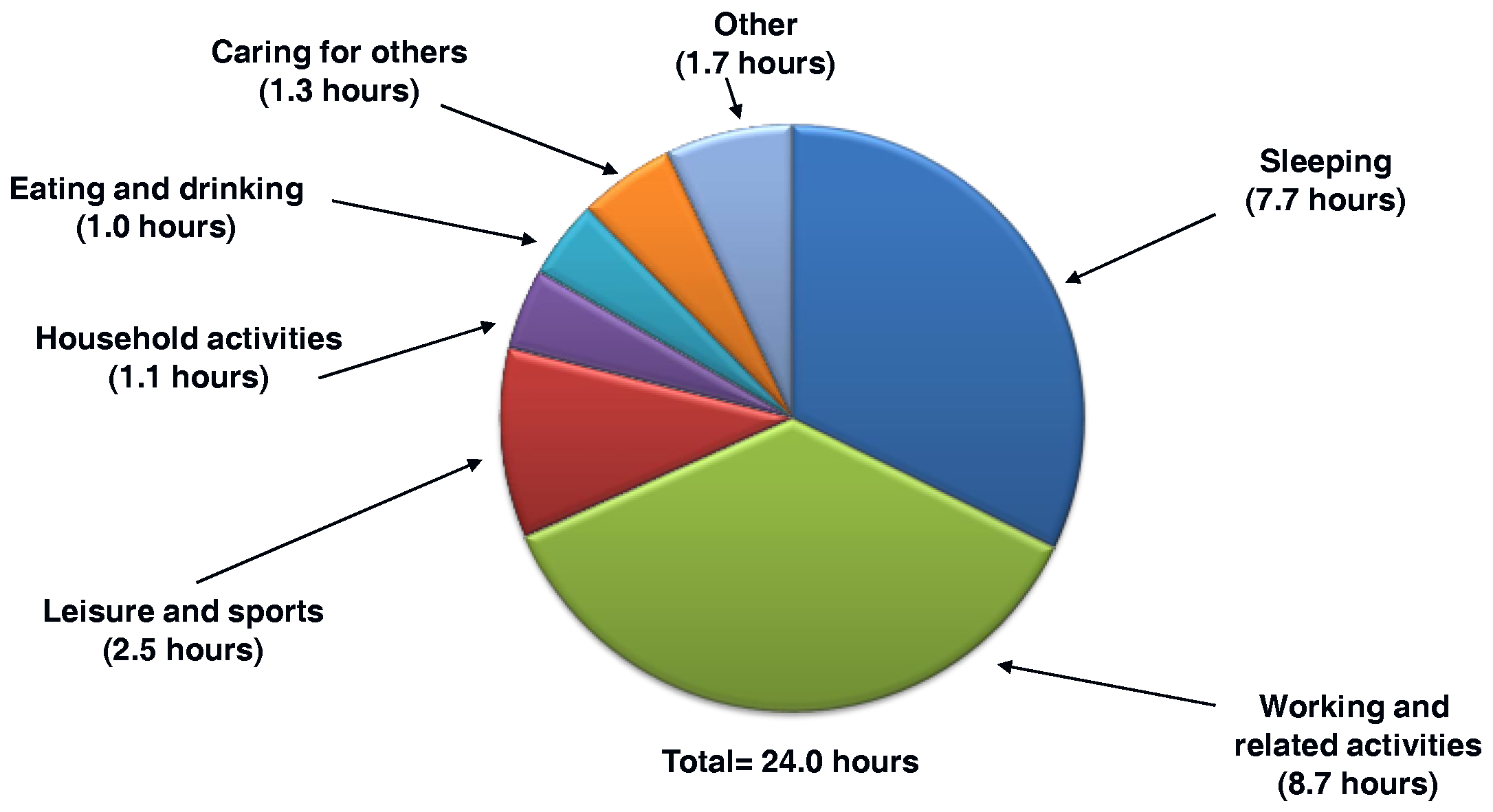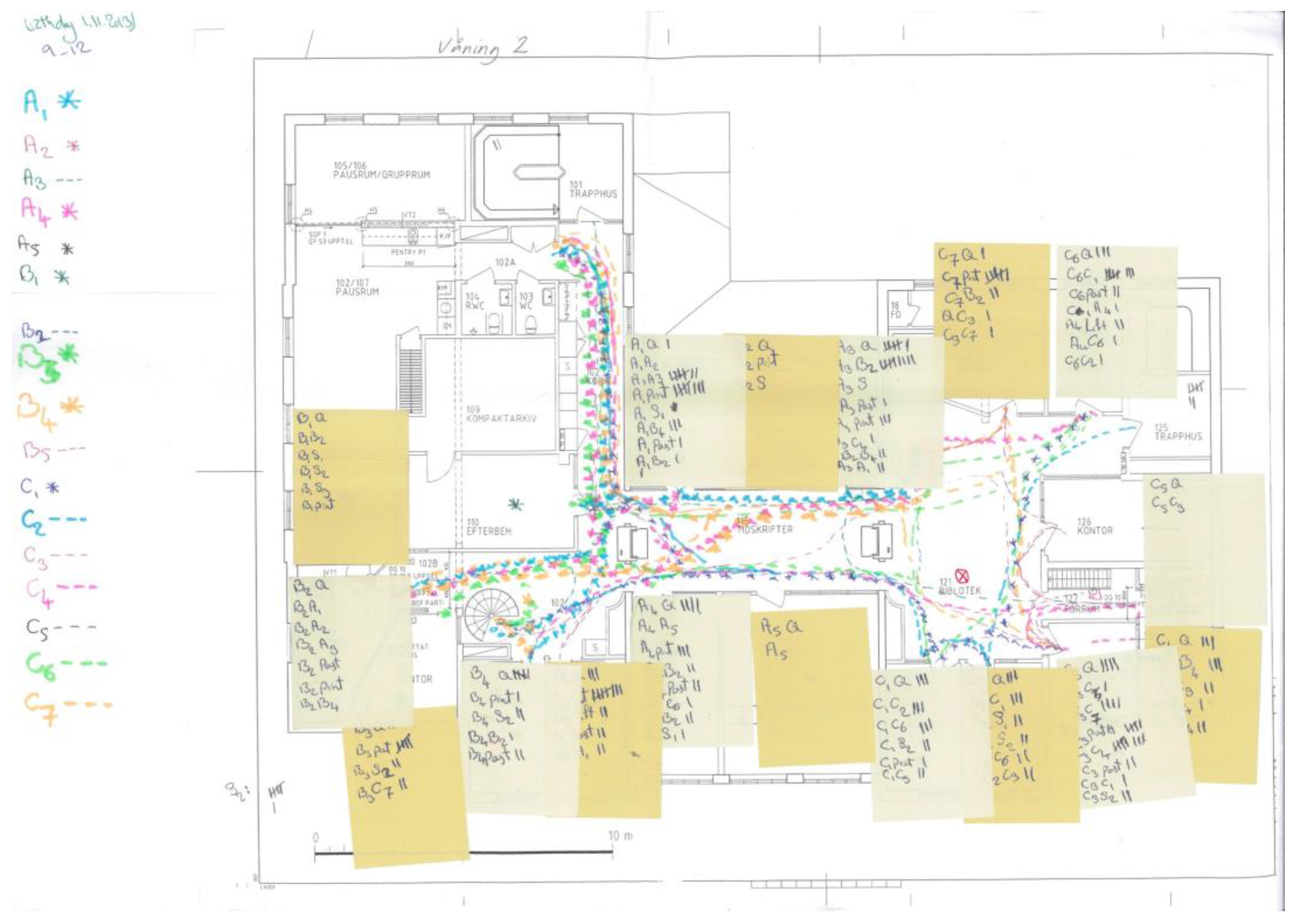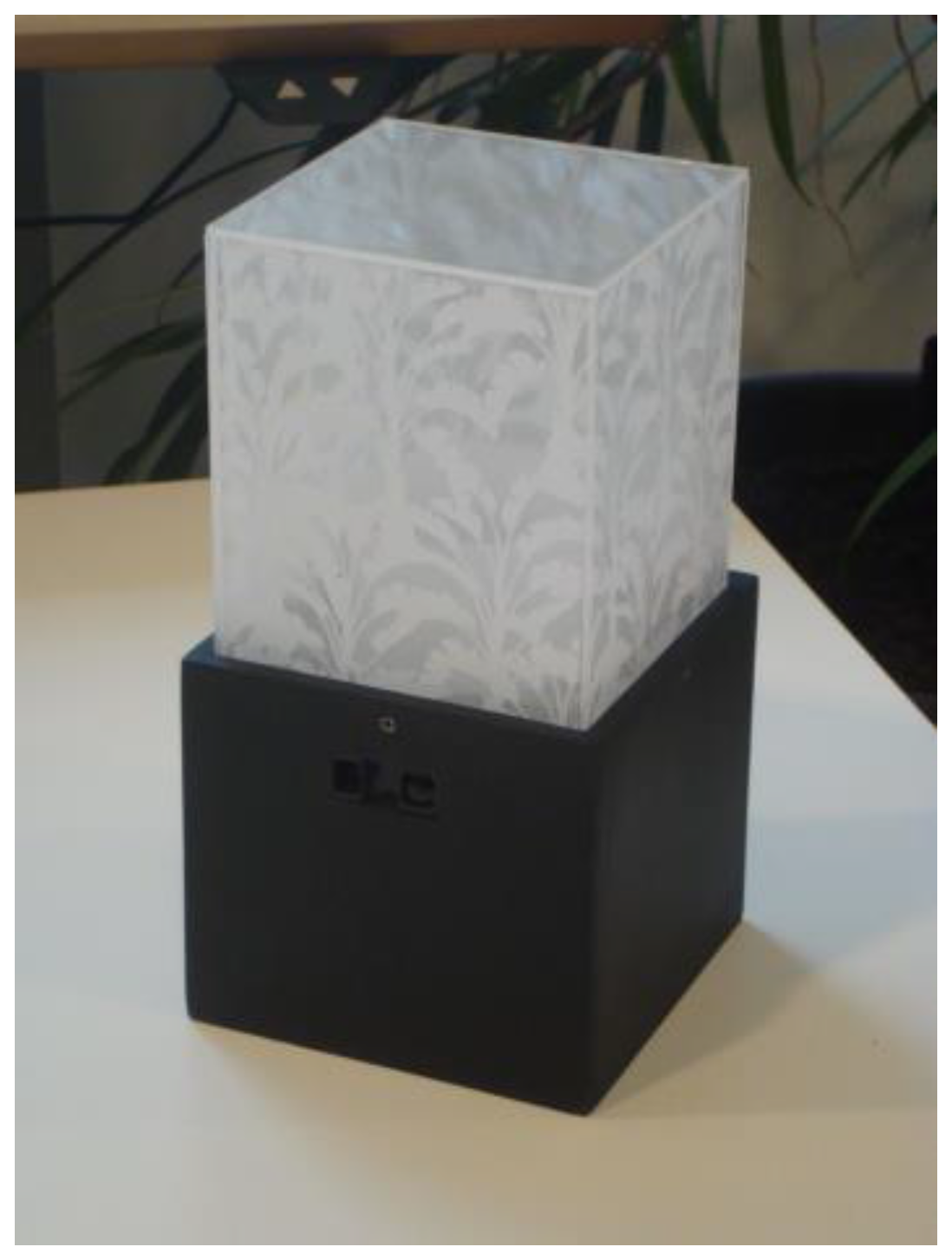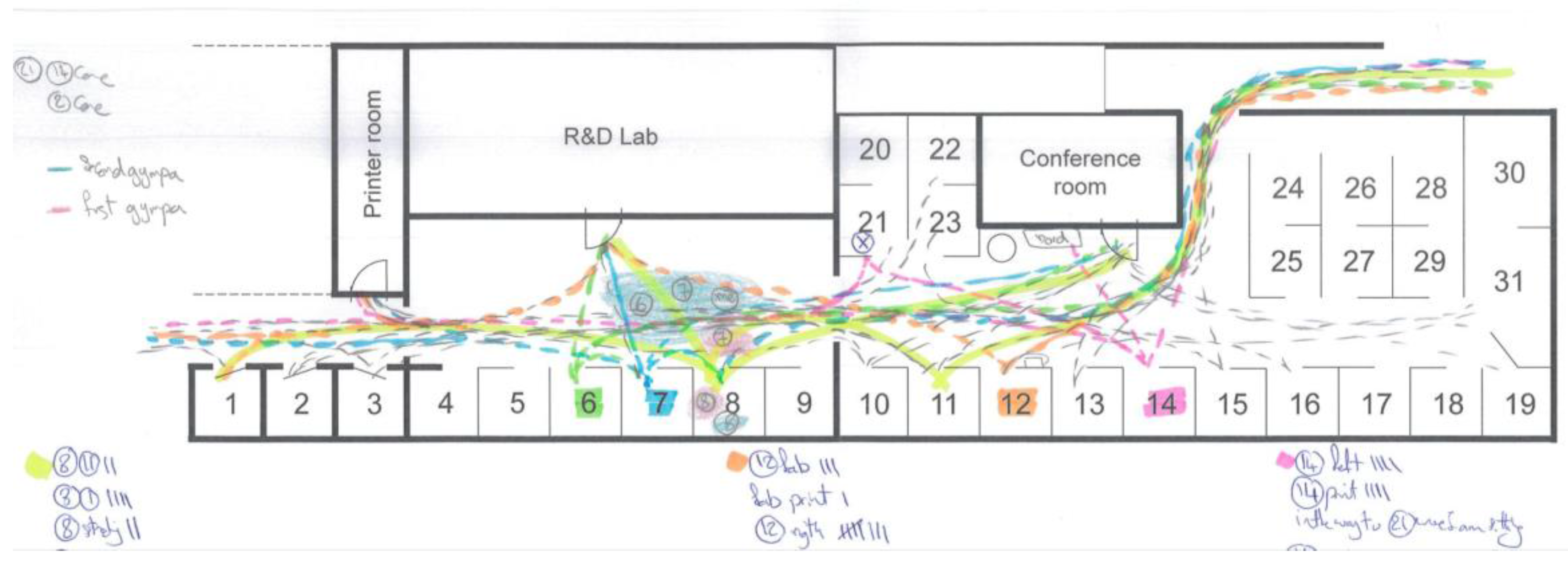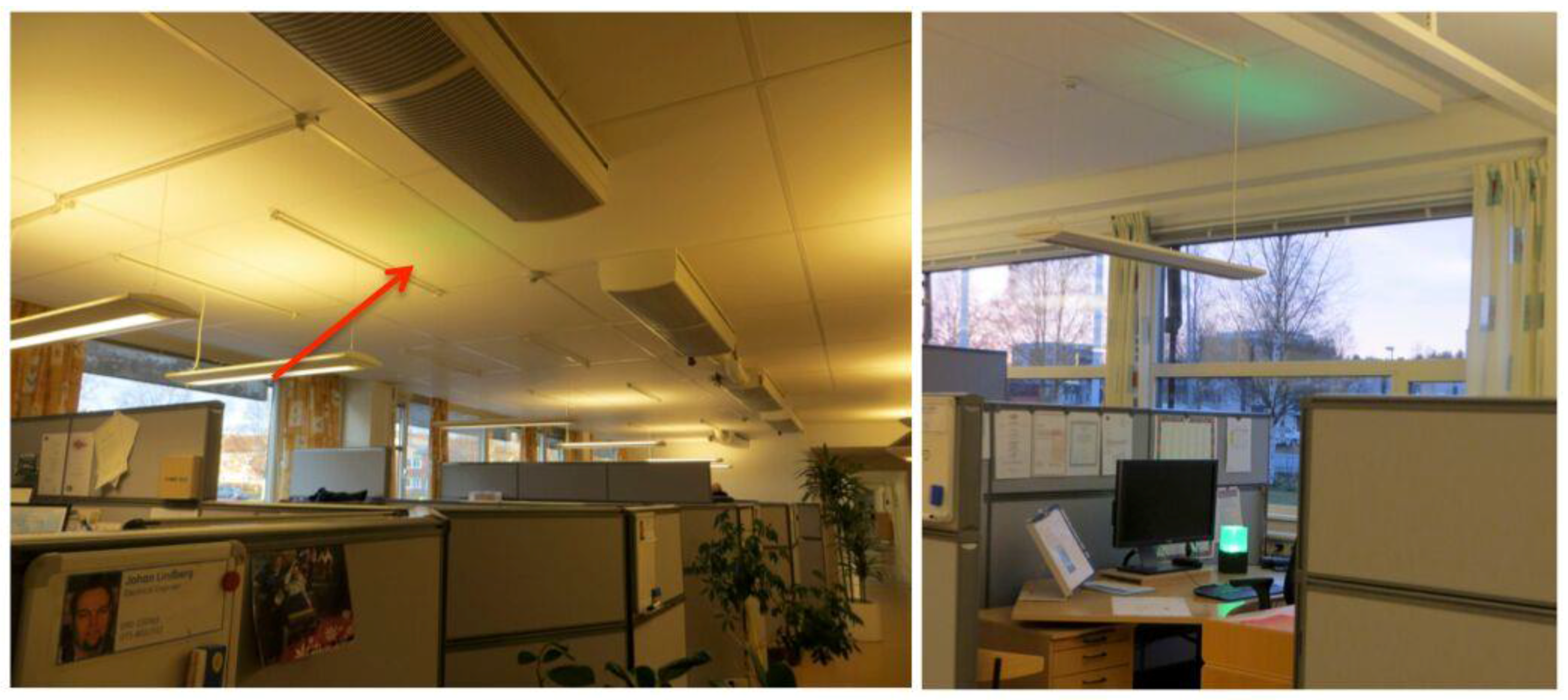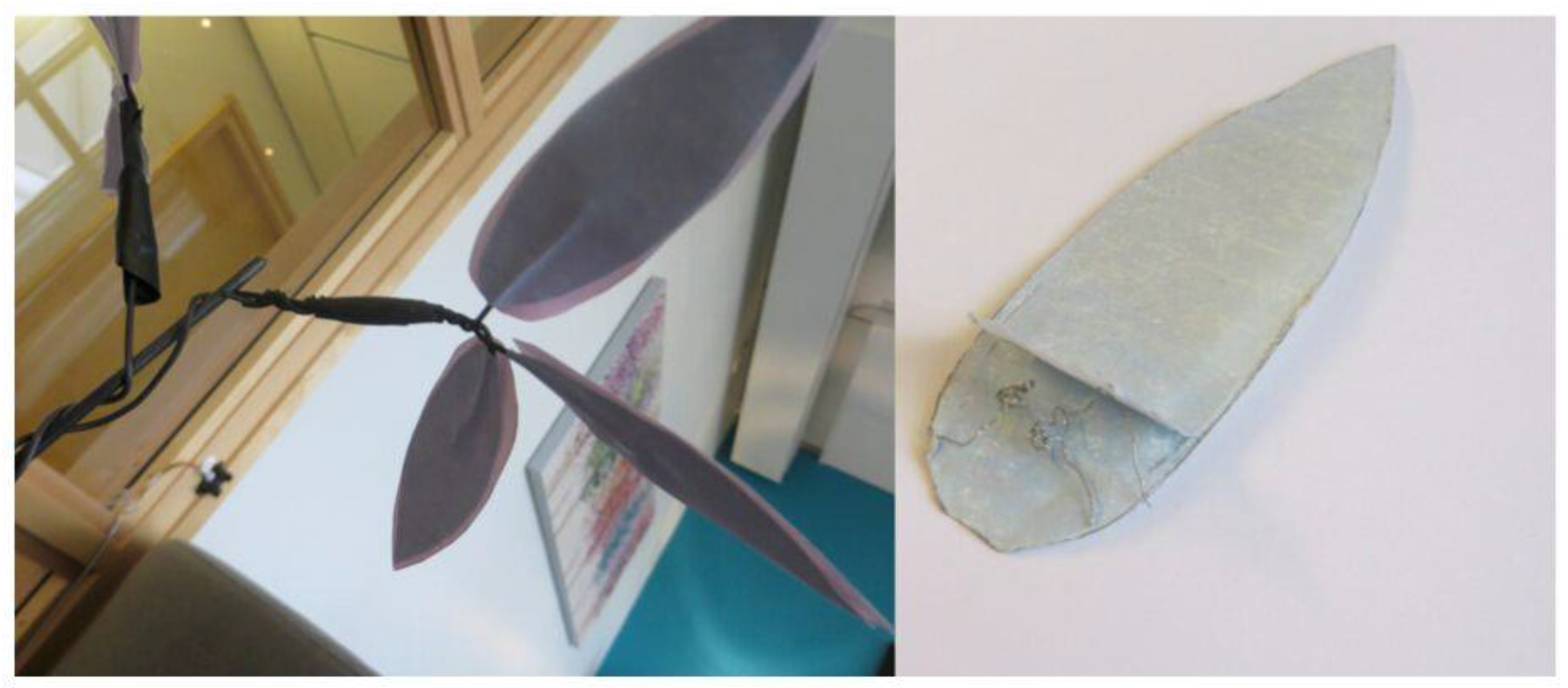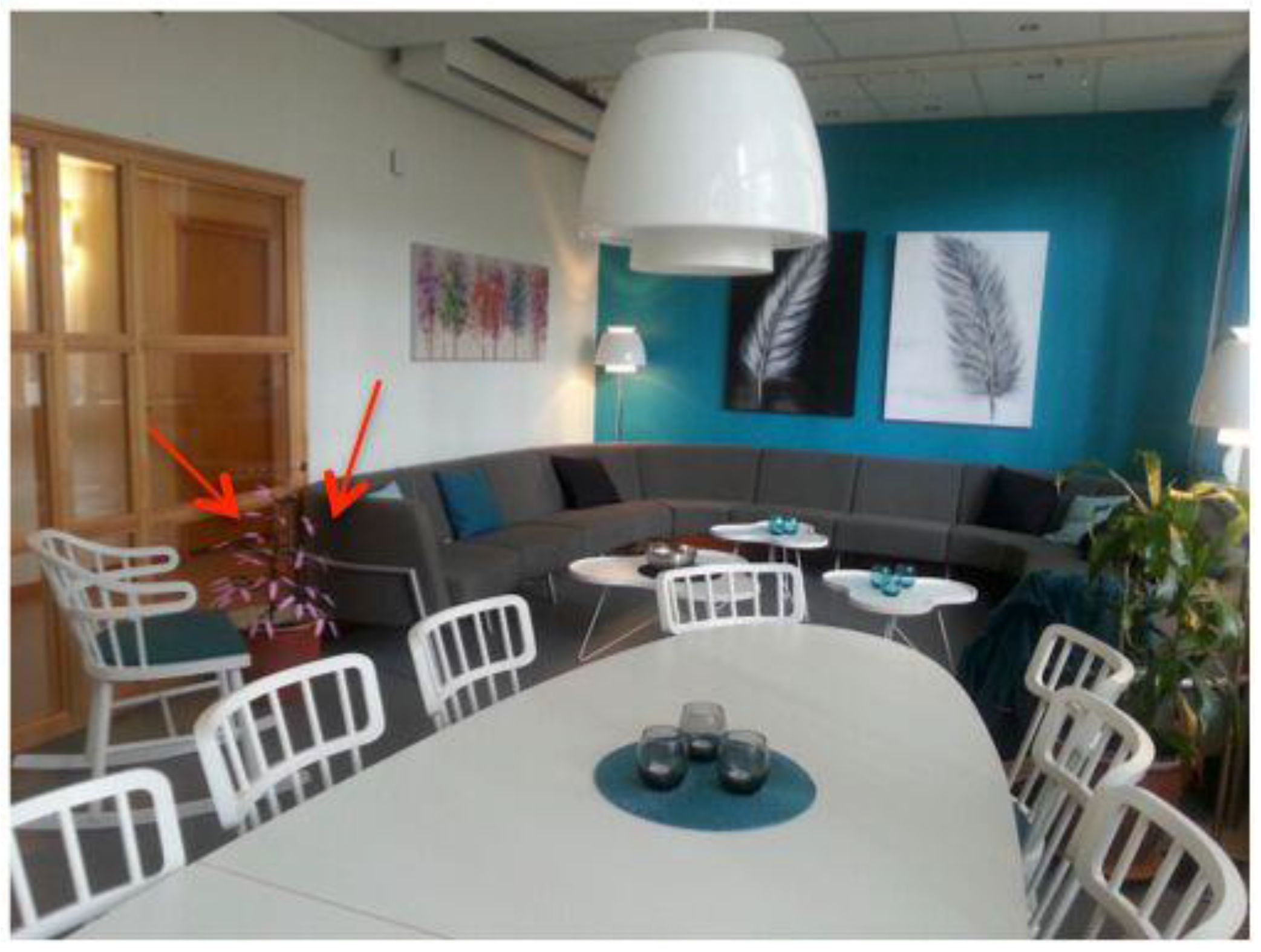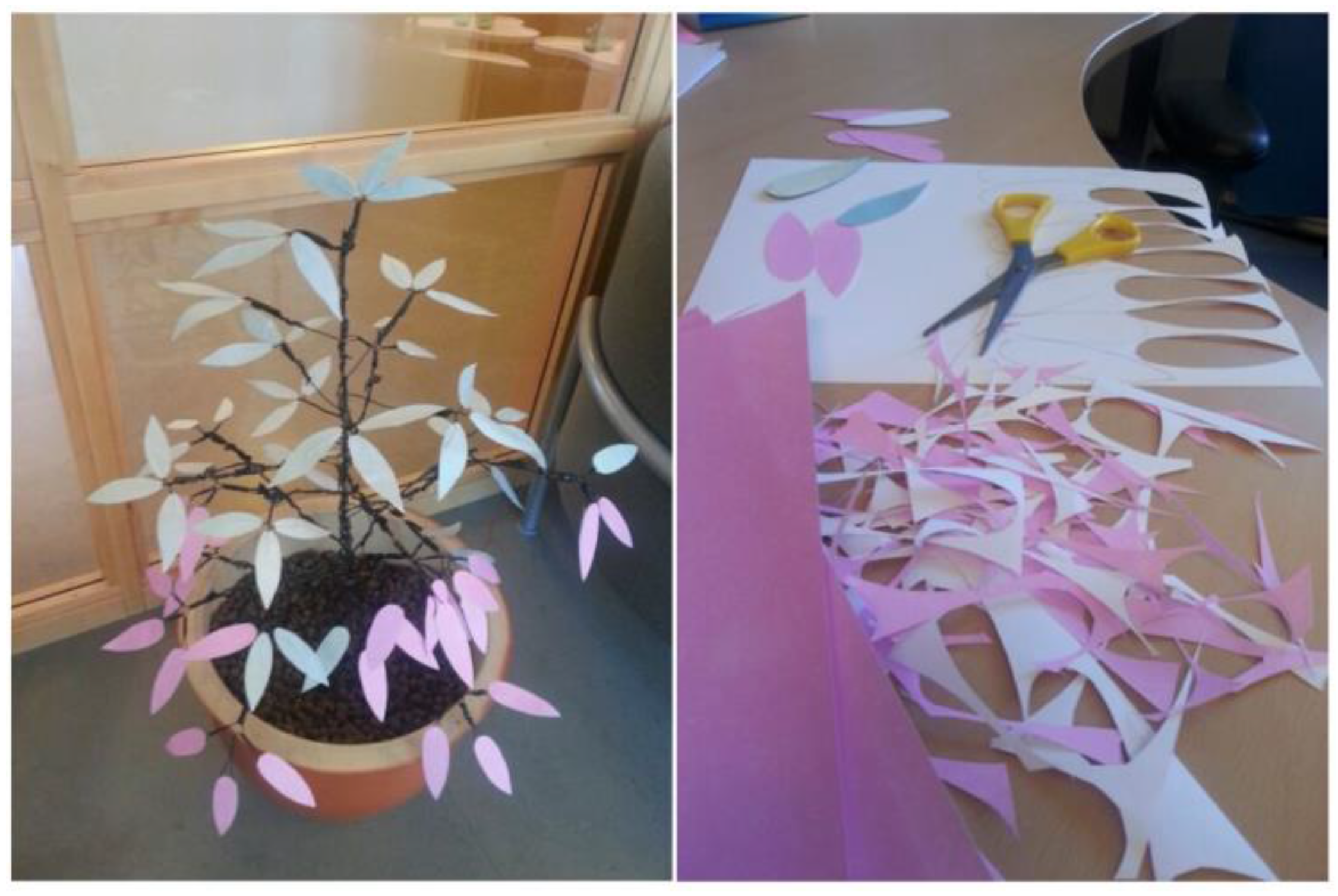1. Introduction
“Personal informatics” (PI) and “quantified self” (QS) are two contemporary notions that foreground interaction design has focused on for a more active way of living our lives. Over the last few years these body- and movement-centered, information-based feedback systems have developed from simple step counters to complex smart watches [
1,
2]. Many such personal computing systems have been designed, ranging from smartphone applications and wearable sensors to ambient displays, and are now being widely adopted [
3,
4,
5,
6,
7,
8,
9,
10,
11,
12]. These systems support the creation of an awareness of users’ activity levels, helping them to increase their daily movement. Such systems, typically referred to as PI or QS systems, have focused on interaction design aimed at encouraging physical activity and to break sedentary habits in daily life. A handful of such products have recently been made available commercially, including, for example, Fitbit, Nike+, Jawbone and Apple Watch. The way these devices have been designed, constructed and used has focused on providing lots of detailed information to the user from an individual perspective. Investigating various aspects of such PI systems has been the focus of much published literature in recent years [
1,
2,
9,
13,
14,
15,
16,
17].
However, beyond this first-person/user-centered perspective surrounding the design and use of PI systems, our work suggests that it is important not to neglect the fact that we spend a lot of our time in social settings, not least in work environments. According to the Department of Labor in the United States (
http://www.bls.gov/tus/charts/), adults aged 25 to 54 with children spend more than 8 hours per day on work-related activities (see
Figure 1). Therefore, for most working adults, time spent stationary and sitting within workspaces contributes most to the overall sitting time in their daily lives [
18]. Still, the current PI/QS movement, or at least the design rationale underpinning the development of new QS devices and applications, tends not to account for this social aspect of everyday non-activity. Accordingly, our project is an attempt to address this perspective in the design of PI systems, which could help to increase everyday movement in the modern workplace.
2. Background and Related Work
As a result of an inactive lifestyle, the incidence of overweight individuals and obesity is becoming a major problem worldwide. According to a number of recently conducted medical studies, prolonged sitting increases the risk of causes of mortality, including cardiovascular disease (CVD), certain types of cancer, and non-CVD/noncancer mortality in adults [
32,
33,
34,
35,
36,
37]. Prolonged sitting covers all types of sedentary behavior, including sitting or lying down in all situations associated with working, eating and traveling that incur no more than 1.5 metabolic equivalents [
22,
37].
In recent years, it has become apparent that regular physical activity within the context of everyday practices yields health benefits [
33,
38]. Existing research indicates that non-exercise activity thermogenesis (NEAT), which refers to any physical activity other than sport-type exercise, including work-related activities, has a direct effect on the physiology of weight change [
32,
33].
As discussed above, there have been a variety of PI design projects conducted with the focus of encouraging movement in everyday life. In the field of public health, there have also been a number of attempts in modifying workplaces for increasing physical activity [
18,
32,
33,
34,
35,
36,
37,
38,
39]. Introducing treadmills in offices as a tool to shift from sitting to standing deskwork and increase NEAT is among the most recent attempts for designing active workplaces [
34]. Although the solution is considered an effective way to make changes in this environment, efficient and silent treadmills are still expensive and require substantial space [
35]. Therefore, alternative approaches, such as game-based mobile applications designed to increase NEAT, have recently been explored [
32]. Others have suggested computer break programs for interrupting sedentary office work. One example is “Booster Break”—an organized short exercise routine that is designed to interrupt prolonged siting with the aim to improve physical and psychological health [
9,
36,
39].
Creating awareness of problems associated with sitting still for prolonged periods in workspaces has also been the focus of various QS- and PI-related designs in different formats—ranging from mobile applications to ambient displays [
3,
4,
5,
6,
7,
8,
10,
11,
12]. The QS movement deals with the individual engagement of self-tracking of any kind in order to obtain QS knowledge and act on it [
1,
2,
17]. Standard contemporary QS devices that focus on increasing movement include, for example, Fitbit, Nike+ and Jawbone Up fitness trackers. Quantitative data collection is the first step towards generating meaningful insights for action-taking results [
17,
40]. Similarly, PI systems refer to software and hardware that collect data based on the user’s behavior, and these aim to create reflection with the proper visualization of data. As Li et al. [
14] describes, these systems function in a stage-based model from preparation to collection and integration in order to provide reflection, which finally results in appropriate action. There are handful of research projects that focus on motivating physical activities with the use of a combination of collection and reflection on PI [
1,
14,
16]. Houston is one of the early mobile prototype applications that encourages physical activity by sharing steps with others [
13]. Other designs such as Fish’n’Steps [
12], UbiFit Garden [
5], StepMatron [
8], Shakra [
3] and Body-Bugg [
12] are similar applications that deal with motivating users to increase their physical activities.
Further, visual representation has been considered as an important aspect of PI tools for reflection [
14]. Most physical activity tracking technologies use charts to represent quantified data. One of the challenges ahead of the QS movement is that users are readily interacting with large streams of data but tools for meaning-making are lacking [
2]. As humans, we are more capable of effectively thinking in stories rather than numbers [
17]; therefore some of the QS devices include both dimensions of quantitative and qualitative data representation. In other words, there is an opportunity for making devices that think in terms of story narratives rather than statistics [
2]. Ubicomp researchers have attempted to explore visualizations in the form of living metaphors or informative art displays using abstract art as a way of creating reflection [
41]. It has also been suggested that it would be valuable to design ambient displays with low complexity and a low-engagement interface to encourage physical activity [
4]. A recent example of such an interface is Apple Watch’s design, showing the level of activity. In fact, PI focuses on collecting data for the purpose of gaining self-knowledge through reflection [
16]; therefore the process of reflection could be considered to be the main concept behind the design of any PI system. More importantly, reflection could be viewed as a learning tool that requires skills such as self-awareness, critical analysis, synthesis and evaluation [
16].
As a result, a variety of designs and studies have focused on the use of peripheral or ambient displays for providing reflection on the level of physical activity [
6,
7,
10,
11]. Ambient displays refer to technologies that can provide useful information while blending smoothly into the surrounding environment and that have the ability to move the information from the periphery to the center of human attention and back again [
7,
10]. The concept of ambient displays originates from the design of calm technologies, with the initial example of Mark Weiser’s The Dangling String [
42]. This design has the advantage of conveying information regarding network traffic in an office in a subtle matter [
10,
42]. As Weiser proposes, this technology engages with both the center and periphery of our attention and moves back and forth between the two [
42], thus helping us to increase knowledge and ability without causing information overload. The ambiguous nature of use in these displays creates an agenda for technologies aimed at reflection and moments of mental rest rather than efficiency in performance [
43]. Such designs could aid their users in discussion and open-ended sense-making processes [
1].
3. Design Rational
If reflection in the context of designing PI is ultimately about conceptually crafting how the information feedback system is mirrored, then there is a need for a method supporting this conceptualization.
On the other hand, our aim in this project was to develop prototypes that aid users in discussion and open-ended sense-making around everyday movements. Therefore, the primarily objective of our study was to develop an understanding of local movement and mobility in office spaces. Here, a 5 month ethnographic observation was our first empirical attempt. As it is challenging to generate design rationales based on empirical study, we used a design-driven approach to develop concepts. With the framework established with the help of the design-driven approach from our ethnographic study, we addressed the true activity in workplaces and added a vocabulary for defining local movement and mobility in workspaces. In the end, the design of both of our prototypes, the
NEAT-Lamp and
Talking Tree, was inspired by our empirical studies with a concept-driven design approach [
44].
3.1. Concept-Driven Design Approach
In our project, we used concept-driven design methods as a foundation for advancing PI design [
44]. In concept-driven research, the focus is on knowledge production in the form of theoretical or conceptual development. It involves an exploratory investigation of established theories with the overall aim of improving and widening the range of theory and knowledge. Overall in this type of research, there is a deliberate intention to theorize about the nature of interaction. The concept of the design becomes a carrier of knowledge but also establishes a conceptual framework and challenge for future design work [
44]. The idea is to think about all invisible qualities to reveal the core quality in the concept of the design. The key of a conceptual design is to manifest all the combined knowledge that will influence the design so that the knowledge is embodied in the artifact [
44]. In a similar approach, Höök and Löwgren [
45] introduced the notion of a strong concept, which is generative and also carries the core design idea. They claim that strong concepts are design elements but at the same time are a part of the artifact.
In order to arrive at a well-grounded conceptual framework, we have conducted two extensive ethnographic studies lasting for more than 5 months in two different office-based workspaces (two different companies). During the ethnographic prestudies, we gathered field notes and sketches of local movement and mobility in the office layout (see
Figure 2). Ethnographic studies have been considered as a common approach in the fields of HCI (Human Computer Interaction) and CSCW (Computer Supported Collaborative Work) [
28,
29,
46]. There has in fact been a wide range of ethnographic studies conducted in workplaces with a specific focus on collaboration or efficiency [
30,
31]. However during the last two decades of the 20th century, with the introduction of information and communication technologies, the concept of mobility has expanded and transformed [
47]. Limited numbers of studies have focused on local movement and mobility in workspaces in order to increase collaboration [
30,
31]. Mobility is considered essential for the use of shared resources and communication [
30]. While conducting our ethnographic studies, we very soon realized the need for local movement and mobility as social practices in workspaces (see
Figure 2). In fact, office workers are mobile during work hours, and movement is constantly shaped and reshaped.
3.2. Conceptual Framework
On the basis of our ethnographic work, we have developed a conceptual framework that identifies five categories of agency that are influential in shaping patterns of local movement and mobility in workspaces (see
Figure 3). The process behind the development of this framework consisted of the thematic analysis of the field notes and informal interview transcripts gathered in our observational ethnographic study. The process of data collection as well as the coding was conducted by one of the authors. Initially, the field notes from the study were carefully coded to more than 1200 open codes. These 1200 codes were clustered into five categories. This framework provided us with a deeper understanding of the existing mobility pattern in workspaces. This understanding of the current movement in offices is important for designing novel PI systems for increasing physical activity among office workers. The five categories are as follows.
Spatial Possibility refers to the possibilities that the architectural space offers for certain movements. As an example, depending on where a staircase is located in a building, the movement patterns of the office workers will be altered. The same applies to the interior design of the office spaces. However, this agency is not limited to physical spaces and could also refer to social spaces created for different activities such as talking or taking an exercise break.
Temporal Appropriation is a term referring to particular movements and mobility within the office space tied to a specific point in time. Time in this definition could relate to a specific hour for conducting meetings, exercise breaks or lunch breaks. It could also refer to a day of the week, or a specific week in the month, such as the delivery week.
Social Relation is linked to the social network that is created by office workers in workspaces. These social networks are formed as a result of work responsibilities, in which office workers depend on one another for the completion of a task, for example, individuals who work in the same department. However personal social networks are also visible in workspaces: some office workers establish friendships and form personal relationships.
Object Property characterizes a quality within objects in the workspace that require physical movement towards them for interaction. A simple example would be a printer that requires office workers to walk up to it to collect their printing. In each workspace, there are a number of such objects, equipment or devices, such as coffee machines, white boards and technical equipment.
Organization Policy relating to movement and physical activity of the office workers has an influence on the daily mobility patterns in the workspace. As an example, an organization that encourages their office workers to take exercise breaks twice a day fosters physical movement in the setting. Other polices could include equipping offices with adjustable desks, short walks during lunch hours, or walking meetings.
As stated previously, these five categories of agency are influential in shaping the movement and mobility patterns in a workspace. By spending time in office spaces in order to understand movement therein, these agencies could easily be elucidated. The aim of this conceptual framework is to bring these agencies to our attention while conceptualizing the prototypes as a challenge for future design work.
4. The Design Work
As noted, the concept of design becomes the carrier of knowledge and establishes a conceptual framework. Our framework created challenges for future design work, resulting in the creation of two prototypes [
44]. Designing to increase physical activity in workspaces requires attention and delicacy in order to avoid any disturbance in the flow of work. Reflecting mobility patterns in a digitalized way through ambient displays could be considered to be one solution to this. Because these designs can be tuned out, they could be considered a possible solution to the threat of information overload [
10]. Moreover, the information from the design can inherently shift to the background when the office workers need to focus on other matters. Given the fact that our method in this study was observational ethnography, fixed and strict planning generally was avoided. Our method was conducted in reality and by observing the practices; on the basis of what we observed, we designed our prototypes. We would like to strongly state that we had no knowledge prior to our study on what or how many prototypes we would design and evaluate.
After conducting several brainstorming meetings during the InPhAct Project and discussing the challenges ahead for designing a PI system based on our framework, we came up with two prototypes. Our first prototype, the NEAT-Lamp, is the outcome of our first observational ethnographic study, and similarly, the Talking Tree is the outcome of the second observational ethnographic study. The aim behind the design of these two prototypes was to see how they foster local movement and mobility in workspaces and how the five agencies come into play with these designs. In the following, we describe, in detail, the design rationale behind each and illustrate our observations on how these designs created discussions and moments of reflection on movement and physical activity among office workers. We also describe how these discussions resulted in changes that fostered worker movement during work hours.
4.1. NEAT Lamp
The
NEAT-Lamp is a simple sensor-based lamp that is connected to a computer via a USB connector (see
Figure 4). The lamp is placed on the table in front of the office worker and turns on after 25 min as a reminder that the worker has been stationary during this time. Proximity sensors have been utilized in this design for this matter. The lamp will automatically turn off as soon as the office worker leaves his/her current position. The idea behind the design of this prototype was inspired by the agency of object property within our framework. The goal was to create an object that had the property of fostering movement in the workspace and also created a reminder outside a computer screen or mobile phone. While designing this artifact, we had in mind that the
NEAT-Lamp should not create any disturbance to the work process. Therefore, the design deliberately blends in with the environment, and the color of the light is green so that, combined with the patterns on the shade, it would create the sense of a living plant, which is a common object in workspaces.
4.1.1. Placing and Observation
After conducting a short pilot study using the
NEAT-Lamp, this prototype was introduced to an open-plan workspace. Before installing this gadget, a 3 week ethnographic observation was undertaken in the setting. The aim of this investigation was to become familiar with the workspace and observe how the five agencies in the framework shaped the movement and mobility patterns therein. Moreover, this study was essential in order to figure out how our prototype altered movement and mobility patterns in the workspace. The workplace comprised an open space with cubical offices. The office workers were mostly electrical engineers, mechanical engineers and a software designer working in a test and design department. The five agencies of the framework soon became visible. It was clear that the workers were aware of the problems associated with prolonged sitting, and they had experienced the use of step counters in a competition a year prior to our study. Moreover, a group of them undertook exercise breaks twice a day, an activity promoted by their organization. Furthermore, they were encouraged to take a walk during the lunch hour (see
Figure 5).
NEAT-Lamps were installed on the desks of six volunteers for around 2 months. These volunteers all worked within the same space of a work environment. Initially, all the office workers of that company were informed about the dangers associated with prolonged sitting, but they were not introduced to the
NEAT-Lamp prototype or the details of the study. After the presentation, six office workers volunteered to participate in the study. During this time, observational studies were conducted as the office workers interacted with the prototype. At the beginning of the study, we were interested to investigate how our lamp, as an additional object added to the workspace, encouraged individuals to alter their movement and mobility patterns. However, after a day, we realized that the lamp when lit illuminated the ceiling, making it visible to everyone in the environment (see
Figure 6). Therefore the interaction between the office worker and the lamp was not limited to the individual, but was visible to everyone in the workspace. This light shining on the ceiling created open-ended discussions among office workers concerning their stationary habit when working on computers. As former studies also indicate, office workers would rather know about each other’s identity and their activity levels in order to have discussion with one another [
12]. Additionally, Lin et al. notify that office workers felt more comfortable to have discussions about their activity level with those participants that they were aware of their identity. The same also happened in our study; when we asked the participants if they wanted to withdraw from the study because of privacy matters, they all agreed to continue with the study, and no one felt that their privacy was questioned. Some office workers enjoyed the green light and ignored its message; others tried to change the current situation. In the following, we give two examples of the behavior we observed.
Observation 1: As a result of the properties inherent in this object (the lamp), many of the office workers stared to use their adjustable tables and switched between sitting and standing while working with computers. In other words, the agency of this object created an awareness of the existing opportunity already created by the organization policy.
Observation 2: In another case, one of the office workers stated that whenever two or three lamps were on, they discussed taking an exercise break. In this example, the object property not only created awareness of the organization polices, but also influenced the time for taking exercise breaks (temporal appropriation), creating a trigger for workers in the office to exercise (spatial possibility).
4.1.2. Moving Forward
As illustrated by the observations, we realized that a simple ambient lamp for reflecting PI data was not only visible to the other office workers but also triggered their curiosity. This enthusiasm was not only among those volunteer office workers that were testing the NEAT-Lamp, but also affected others in the workspace. Therefore, once again we were reminded of the importance of the social entity of workplaces when designing prototypes to foster local movement and mobility among office workers. During several brainstorming sessions, we came up with a design for a prototype that reflected not only the stationary behavior of single office workers, but mirrored the local movement and mobility patterns of all individuals in the workspace.
4.2. Talking Tree
Trees have long been a symbol of wisdom in literature and stories. When designing an ambient display to reflect local movement and mobility patterns in workspaces, we tried to relate to this common narrative. Moreover, by definition, ambient displays do not function as intended if they do not properly blend with the environment [
48], and thus when designing in the context of workspaces, plants are useful indigenous artifacts that we noticed during our ethnographic studies.
An effective technology for encouraging physical activity must give proper credit to the users’ activities [
13]. However pedometers sometimes over- or, more often, under-represent the overall level of activity. Therefore, this design avoids using quantified data representations. The
Talking Tree reflects the current collective local movement and mobility level in the space.
The
Talking Tree is a proximity sensor-based interactive plant that reflects the amount of local movement within a corridor by changes in the color of its leaves (see
Figure 7 and
Figure 8). Sensitive colour paper was used for the leaves of this prototype. The idea behind the design of this ambient display is that, on the basis of a predefined parameter measured by a sensor, when a specified threshold is crossed, the leaves will change colour from green to white (
Figure 7 and
Figure 8). The leaves of the
Talking Tree are green until local movement and mobility decreases within the workspace, at which point the sensor is activated and the green colour fades to white. Thus, if there is no movement around the sensors, the
Talking Tree will change colour.
4.2.1. Placing and Observation
This object was placed as a pilot study in the lunchroom of the Department of Informatics (see
Figure 9). The idea is to place this prototype as an artwork or a talking point in a common area such as a lunchroom. Being inspired by our previous experience of the
NEAT-Lamp, this prototype was placed in a way that targeted the social entity of local movement and mobility. Therefore, lunchrooms seemed a perfect candidate in which to place this ambient display that reflects the frequency of local movement and mobility of all office workers. The sensors of the prototype, however, were placed in the main corridor of the office space to collect data from the movement of the office workers. As the
Talking Tree collectively gathers data from all the office workers in the environment in an anonymous manner, thus privacy in our view is not an issue.
During this time, we faced challenges in implementing the design, some of which were solved. These challenges resulted in the replacement of the sensor and changes to the prototype. One of the initial challenges in the pilot study was the visibility of the color change in the leaves. Because of the light coming from the windows and the lamps within the lunchroom, it was hard to perceive the color change in the prototype. As a result, we decided to change the colors of the leaves to a darker color (see
Figure 10).
Despite the changes ahead of the pilot testing of the Talking Tree, overall, the reaction towards the plant was very positive. The office workers in the Department of Informatics appreciated the idea and the concept of the design. Mostly, they considered the prototype from an aesthetic point of view and expressed their preference for the pink color of the leaves. Apart from the charming look of the prototype, the Talking Tree was successful in relation to our conceptual framework. During the 2 month pilot study, we heard many informal discussions related to local movement and mobility patterns among office workers.
Observation 1: In informal talks, which were sometimes humorous, office workers reflected on their spatial possibilities and discussed ways of expanding their possibilities for more movement by using other object properties. As an example, one of the office workers who had a printer in her room reflected that it might be better if she stopped using her printer and instead tried to use the printers in the printing room.
Observation 2: More office workers reflected on their organization polices, thinking of ways to improve the situation in the department by requesting adjustable tables and having walking meetings. In having walking meetings, they were investigating temporal appropriation. While some discussed these agencies for increasing their local movement and mobility, others decided to take a lunch walk with those that were close to them (social relation).
4.2.2. Future Steps
Although the reaction towards the Talking Tree was, as we anticipated, based on the conceptual framework of the design, this was only the early stage of developing this prototype. After debugging this design, we plan to conduct a full study of the design in an office environment. Similarly to our previous attempts, this study will also be accompanied by an observational study. Hopefully, this study will provide valuable insights to allow us to develop similar designs and our conceptual framework as the foundation for the prototypes. Finally, such feedback may result in theoretical developments regarding the design of PI systems in social settings such as office spaces in order to increase local movement and mobility.
5. Discussion
We hope that by presenting our conceptual framework and challenges associated with our design work, we have opened up the discussion regarding the design of PI systems for office spaces. By introducing our conceptual framework, first we wished to draw attention to existing local movements in workspaces. Being locally mobile in workspaces is an embedded practice in socially constructed workplaces (see
Figure 2 and
Figure 5). Although a number of ethnographic studies have mentioned this point [
30,
31], designers in the field of PI and QS systems have disregarded this fact.
Moreover, we wish to point out that this socially embedded practice of local movement and mobility is shaped by five agency categories (see
Figure 3). When designing PI systems that promote movement and physical activity, there should be specified sustainable link agencies. A PI system that neglects the agencies that affect movement in offices might face the risk of office workers losing interest in using the system [
12]. We argue that having this conceptual framework as a driving force behind the novel designs of PI in offices can create social reflection about movement therein. This social reflection will create awareness and promote collective discussion on finding ways to break stationary habits.
We are aware that there have been many designs that have used ambient displays to create awareness of the matter of prolonged sitting and encouraging physical activity in office settings [
6,
7,
10,
11]. Our two prototypes also use ambient displays as a way to raise awareness of this issue. However, the ways that the
NEAT-Lamp and the
Talking Tree were observed and analyzed on the basis of our conceptual framework contribute to our discussion. We are not suggesting that discussion around creating opportunities to increase movement and reflecting on the current setting does not happen in association with existing PI systems, but the critical observation of such actions and discussions using the conceptual framework adds an extra dimension. These designs represent an entry point to designing PI systems deliberately to foster social inventions by creating open-ended discussions [
1].
The benefit of such a conceptually driven design, we argue, is going beyond individual interactions and data representations. Rather than using the social aspect of using PI systems as a side-effect or as an add-on trigger [
1,
8], discussion and socially reflective actions become the main source of behavior change. More sustainable change can be achieved once we shed light on how socially embedded we are in our daily practices, in particular, in office environments. As noted, the social role of the affectivity in PI systems in workspaces is an unexplored topic in HCI.
We initially started with the design of the NEAT-Lamp as an individual interactive sensor-based lamp, tackling the five agencies of an individual’s local movement and mobility in offices. However, this simple lamp illuminated a new path in our research in which individual interactions with the design created a reflection visible to everyone in the setting. This unanticipated outcome made a clear point to us that in order to create a change away from the stationary nature of work, all office workers should be aware and willing to play a part. Therefore, this experience led us to the design of our second prototype, the Talking Tree.
The challenges ahead of us in this project have made us reflect on our own practice [
49] and think that perhaps the answer lies in the emergence of ideas behind critical design in designing PI systems. As the aim of critical design is to provide critical doubt about everyday life and its aspects, agendas and values, it could be a good starting point to reflect on the current situation. It could assist users in challenging ideologies and behavioral norms through designs that embody alternative social, cultural, technical or economic values [
50]. This type of design is described as a form of social research in that the intended outcome is knowledge rather than the design of a final product addressing a specific problem. Impressively, by conducting research using the concept-driven design approach, we are exploring an end result optimized in relation to a specific idea, concept, or theory rather than a final design for a specific problem, user, or a particular use context [
44], which perfectly resonates with ideas behind critical design. Therefore critical design can be characterized as an attitude rather than a method [
50].
6. Conclusions
This paper has articulated a conceptual framework for understanding local movement and mobility within a workspace. This framework characterizes five agencies that shape movement patterns in offices and the way these could be affected. On the basis of this conceptual framework, two prototypes were designed in order to increase local movement and mobility in offices. The two designs, the NEAT-Lamp and the Talking Tree, are discussed in detail at the end of this paper.
The paper begins with a description of the motivations behind studying PI systems in office-based contexts. In doing so, it provides a review of existing PI devices and related research in this field. The paper then introduces our research from the viewpoint of a transdisciplinary research project aimed at investigating ways to increase physical activity and breaking the habit of prolonged sitting in office settings. As part of this project, two ethnographic studies lasting more than 5 months in two different offices were conducted. By characterizing the five different agencies that affect local movement and mobility in offices, this paper draws attention to the role of socially embedded practices of local mobility patterns in workspaces.
The paper then continues by introducing two design prototypes that were placed in two different office spaces. On the basis of observations, the paper describes how the prototypes created social discussion among the office workers regarding their mobility patterns during work hours. Considering the conceptual framework, the discussions resulted in expanding one or several categories of agency related to everyday movement patterns.
The paper concludes by discussing the importance of considering social elements when designing PI systems for office environments and the benefits of our proposed conceptual framework. Moreover, it continues by outlining the role of reflection in creating social awareness of local movement and mobility. Finally, we have suggested an alternative way of designing PI systems with the emergence of critical design, assisting users to challenge their behavior patterns and embody alternative cultures that suit their situation. Therefore, the aim of such design work would not be to create a product that immediately increases physical movement; on the contrary, the outcome would be the knowledge gained, reflections generated, and discussions among the office workers regarding their everyday movement and mobility patterns. In relation to the existing strand of research on PI design, this paper offers two contributions. First, it provides a conceptual framework in relation to agencies that shape local movement and mobility in office environments. Second, it introduces two prototypes designed for sparking collective reflections and discussions on mobility and everyday movement in offices.
